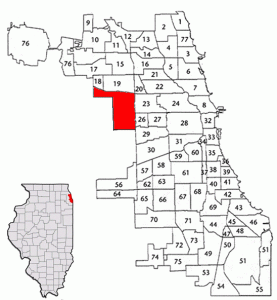
Highlighted: the Austin neighborhood of Chicago, Ill.
Juvenile advocates and researchers in Illinois came together for a one-day workshop to discuss juvenile arrest data from the Austin and Lawndale neighborhoods of Chicago along with the alternatives to incarceration for juvenile offenders.
Austin, Chicago’s largest neighborhood by population, ranked third in total juvenile arrests in 2010. The number of kids under the age of 17 arrested in Chicago has dropped in recent years, according to a report released by the First Defense Legal Aid and Project NIA during the seminar. But advocates say the system hasn’t changed enough and continues to disserve kids on the west side of the city, especially African Americans.
In 2008 African Americans accounted for 78 percent of juvenile arrests in the city of Chicago, Hispanics for 18 percent and whites for just 3.5 percent, according to the same report. Advocates contest the system focuses too much on incarceration and punishment of young offenders and not enough on prevention.
“It just makes no sense,” Betsy Clarke, founder and president of the Illinois Juvenile Justice Initiative, told a reporter with AustinTalks. “Courts should be our last resort.”
Nationally about 55 percent of juveniles released from incarceration are rearrested within one year. In urban areas recidivism rates tend to be higher, in some cities reaching into the 70-80 percentile, according to a report from Stanford University.
Workshop presenters purposed a number of alternatives including youth jobs programs, mentoring for kids with single parents and working more closely with local police, according to AustinTalks.
Read the full report: “ARRESTING JUSTICE: A Report About Juvenile Arrests in Chicago 2009 & 2010”
